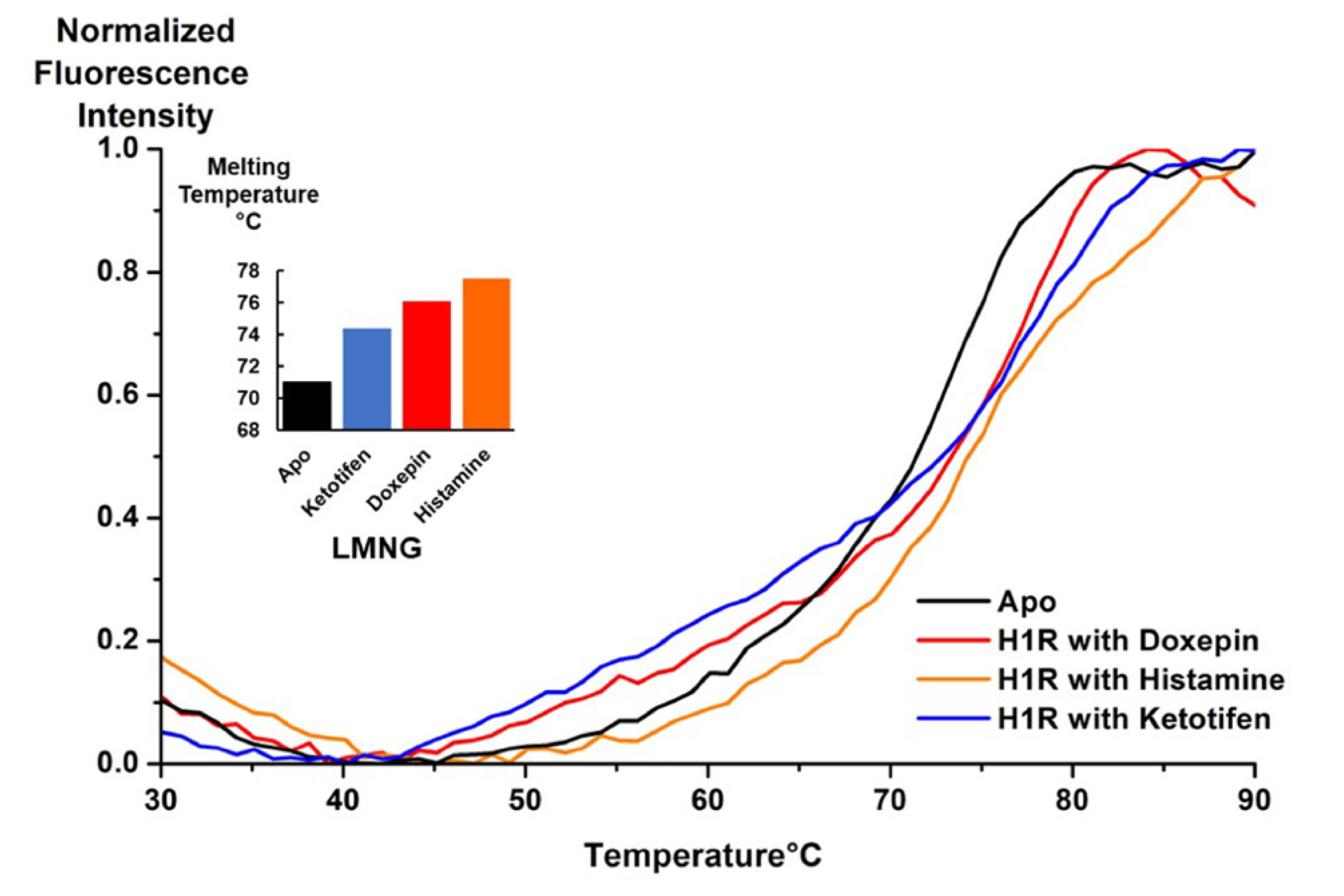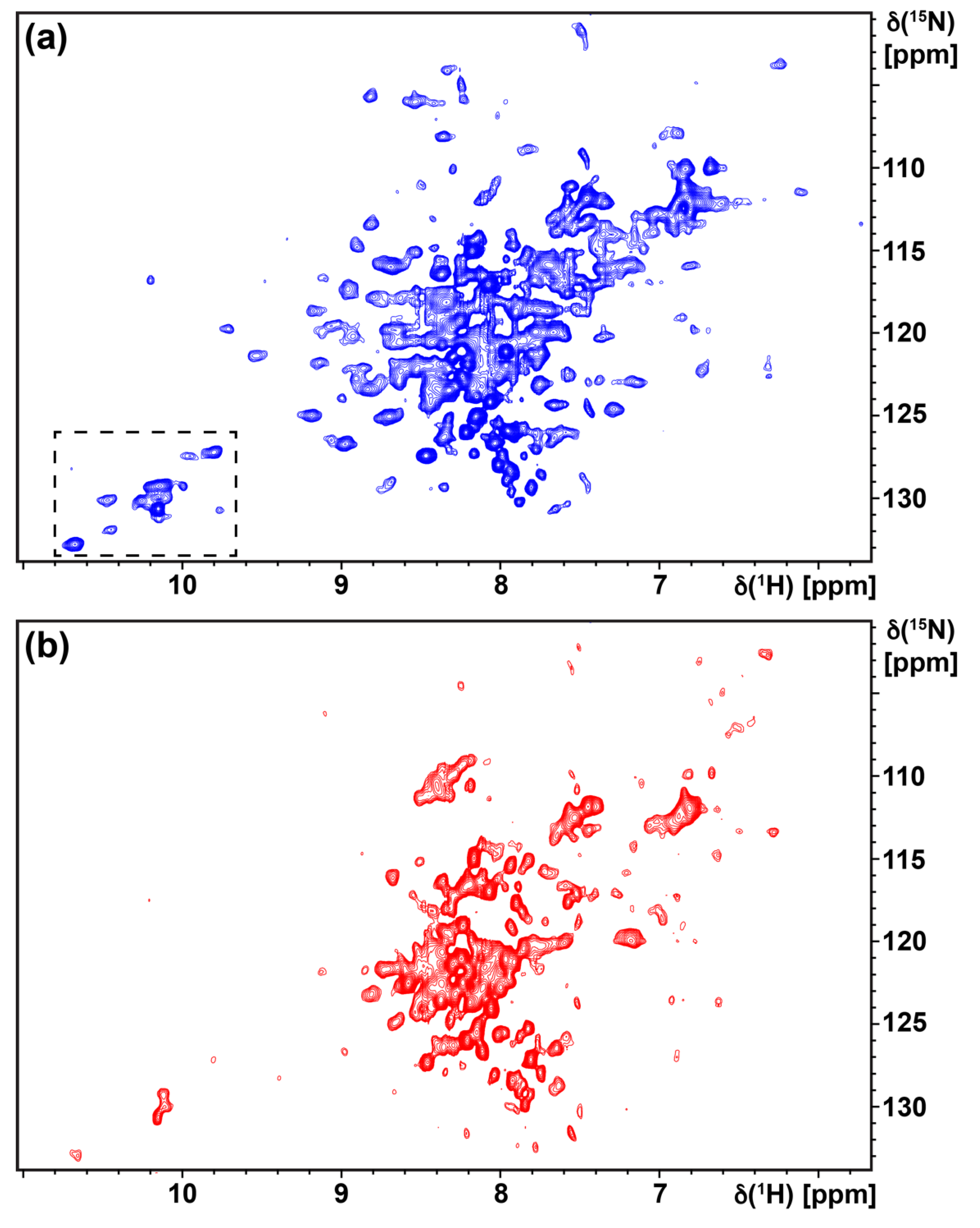Production of a Human Histamine Receptor for NMR Spectroscopy in Aqueous Solutions
Abstract
1. Introduction
2. Materials and Methods
2.1. Materials and Reagents
2.2. Transformation and Colony Screening
2.3. Optimization of H1R Expression Conditions
2.4. H1R Production and Purification for NMR Experiments
2.5. Fluorescence Thermal Shift Assays
2.6. NMR Spectroscopy
3. Results
3.1. Design of an H1R Expression Vector for NMR Studies
3.2. Optimization of H1R Expression and Purification Conditions
3.3. H1R Response to Ligand Binding
3.4. Spectroscopic Characterization of Solutions Containing Purified H1R by 2-Dimensional TROSY NMR
3.5. Response to Changes in Efficacy of Bound Drugs Monitored by 19F-NMR Spectroscopy
4. Discussion
4.1. Production of Stable-Isotope Labeled Human GPCRs in Pichia Pastoris
4.2. Tryptophans as NMR Probes of GPCR Structure-Function Relationships
5. Conclusions
Author Contributions
Funding
Conflicts of Interest
References
- Hauser, A.S.; Attwood, M.M.; Rask-Andersen, M.; Schiöth, H.B.; Gloriam, D.E. Trends in GPCR drug discovery: New agents, targets and indications. Nat. Rev. Drug Discov. 2017, 16, 829–842. [Google Scholar] [CrossRef] [PubMed]
- Hill, S.J.; Ganellin, C.R.; Timmerman, H.; Schwartz, J.C.; Shankley, N.P.; Young, J.M.; Schunack, W.; Levi, R.; Haas, H.L. International Union of Pharmacology. XIII. Classification of histamine receptors. Pharmacol. Rev. 1997, 49, 253–278. [Google Scholar]
- Hill, S.J. Distribution, properties, and functional characteristics of three classes of histamine receptor. Pharmacol. Rev. 1990, 42, 45–83. [Google Scholar]
- Barbier, A.J.; Bradbury, M.J. Histaminergic control of sleep-wake cycles: Recent therapeutic advances for sleep and wake disorders. CNS Neurol. Disord. Drug Targets 2007, 6, 31–43. [Google Scholar] [CrossRef]
- O’Mahony, L.; Akdis, M.; Akdis, C.A. Regulation of the immune response and inflammation by histamine and histamine receptors. J. Allergy Clin. Immunol. 2011, 128, 1153–1162. [Google Scholar] [CrossRef]
- Shi, Z.; Fultz, R.S.; Engevik, M.A.; Gao, C.; Hall, A.; Major, A.; Mori-Akiyama, Y.; Versalovic, J. Distinct roles of histamine H1- and H2-receptor signaling pathways in inflammation-associated colonic tumorigenesis. Am. J. Physiol. Gastrointest Liver Physiol. 2019, 316, G205–G216. [Google Scholar] [CrossRef]
- Shimada, I.; Ueda, T.; Kofuku, Y.; Eddy, M.T.; Wüthrich, K. GPCR drug discovery: Integrating solution NMR data with crystal and cryo-EM structures. Nat. Rev. Drug Discov. 2019, 18, 59–82. [Google Scholar] [CrossRef]
- Klabunde, T.; Hessler, G. Drug design strategies for targeting G-protein-coupled receptors. Chembiochem 2002, 3, 928–944. [Google Scholar] [CrossRef]
- Shimamura, T.; Shiroishi, M.; Weyand, S.; Tsujimoto, H.; Winter, G.; Katritch, V.; Abagyan, R.; Cherezov, V.; Liu, W.; Han, G.W.; et al. Structure of the human histamine H1 receptor complex with doxepin. Nature 2011, 475, 65–70. [Google Scholar] [CrossRef]
- Xia, R.; Wang, N.; Xu, Z.; Lu, Y.; Song, J.; Zhang, A.; Guo, C.; He, Y. Cryo-EM structure of the human histamine H 1 receptor/G q complex. Nat. Commun. 2021, 12, 1–9. [Google Scholar] [CrossRef]
- André, N.; Cherouati, N.; Prual, C.; Steffan, T.; Zeder-Lutz, G.; Magnin, T.; Pattus, F.; Michel, H.; Wagner, R.; Reinhart, C. Enhancing functional production of G protein-coupled receptors in Pichia pastoris to levels required for structural studies via a single expression screen. Protein Sci. 2006, 15, 1115–1126. [Google Scholar] [CrossRef] [PubMed]
- Noguchi, S.; Satow, Y. Purification of human beta2-adrenergic receptor expressed in methylotrophic yeast Pichia pastoris. J. Biochem. 2006, 140, 799–804. [Google Scholar] [CrossRef] [PubMed]
- Asada, H.; Uemura, T.; Yurugi-Kobayashi, T.; Shiroishi, M.; Shimamura, T.; Tsujimoto, H.; Ito, K.; Sugawara, T.; Nakane, T.; Nomura, N.; et al. Evaluation of the Pichia pastoris expression system for the production of GPCRs for structural analysis. Microb. Cell Fact. 2011, 10, 24. [Google Scholar] [CrossRef]
- de Jong, L.A.; Grünewald, S.; Franke, J.P.; Uges, D.R.; Bischoff, R. Purification and characterization of the recombinant human dopamine D2S receptor from Pichia pastoris. Protein Expr. Purif. 2004, 33, 176–184. [Google Scholar] [CrossRef] [PubMed]
- Sarramegna, V.; Demange, P.; Milon, A.; Talmont, F. Optimizing functional versus total expression of the human mu-opioid receptor in Pichia pastoris. Protein Expr. Purif. 2002, 24, 212–220. [Google Scholar] [CrossRef]
- Ye, L.; Van Eps, N.; Zimmer, M.; Ernst, O.P.; Prosser, R.S. Activation of the A2A adenosine G-protein-coupled receptor by conformational selection. Nature 2016, 533, 265–268. [Google Scholar] [CrossRef]
- Clark, L.D.; Dikiy, I.; Chapman, K.; Rödström, K.E.; Aramini, J.; LeVine, M.V.; Khelashvili, G.; Rasmussen, S.G.; Gardner, K.H.; Rosenbaum, D.M. Ligand modulation of sidechain dynamics in a wild-type human GPCR. Elife 2017, 6. [Google Scholar] [CrossRef]
- Huang, S.K.; Pandey, A.; Tran, D.P.; Villanueva, N.L.; Kitao, A.; Sunahara, R.K.; Sljoka, A.; Prosser, R.S. Delineating the conformational landscape of the adenosine A2A receptor during G protein coupling. Cell 2021, 184, 1884–1894. [Google Scholar] [CrossRef]
- Eddy, M.T.; Martin, B.T.; Wüthrich, K. A2A Adenosine Receptor Partial Agonism Related to Structural Rearrangements in an Activation Microswitch. Structure 2021, 29, 170–176. [Google Scholar] [CrossRef]
- Eddy, M.T.; Gao, Z.-G.; Mannes, P.; Patel, N.; Jacobson, K.A.; Katritch, V.; Stevens, R.C.; Wüthrich, K. Extrinsic Tryptophans as NMR Probes of Allosteric Coupling in Membrane Proteins: Application to the A2A Adenosine Receptor. J. Am. Chem. Soc. 2018, 140, 8228–8235. [Google Scholar] [CrossRef]
- Sušac, L.; Eddy, M.T.; Didenko, T.; Stevens, R.C.; Wüthrich, K. A2A adenosine receptor functional states characterized by 19F-NMR. Proc. Nat. Acad. Sci. USA 2018, 115, 12733–12738. [Google Scholar] [CrossRef]
- Eddy, M.T.; Lee, M.-Y.; Gao, Z.-G.; White, K.L.; Didenko, T.; Horst, R.; Audet, M.; Stanczak, P.; McClary, K.M.; Han, G.W.; et al. Allosteric Coupling of Drug Binding and Intracellular Signaling in the A2A Adenosine Receptor. Cell 2017, 1–26. [Google Scholar] [CrossRef] [PubMed]
- Ye, L.; Neale, C.; Sljoka, A.; Lyda, B.; Pichugin, D.; Tsuchimura, N.; Larda, S.T.; Pomès, R.; García, A.E.; Ernst, O.P.; et al. Mechanistic insights into allosteric regulation of the A2A adenosine G protein-coupled receptor by physiological cations. Nat. Commun. 2018, 9, 1372. [Google Scholar] [CrossRef] [PubMed]
- Clark, L.; Dikiy, I.; Rosenbaum, D.M.; Gardner, K.H. On the use of Pichia pastoris for isotopic labeling of human GPCRs for NMR studies. J. Biomol. NMR 2018, 71, 203–211. [Google Scholar] [CrossRef] [PubMed]
- Sušac, L.; O’Connor, C.; Stevens, R.C.; Wüthrich, K. In-Membrane Chemical Modification (IMCM) for Site-Specific Chromophore Labeling of GPCRs. Angew. Chem. 2015, 127, 15461–15464. [Google Scholar] [CrossRef]
- Alexandrov, A.I.; Mileni, M.; Chien, E.Y.T.; Hanson, M.A.; Stevens, R.C. Microscale Fluorescent Thermal Stability Assay for Membrane Proteins. Structure 2008, 16, 351–359. [Google Scholar] [CrossRef]
- Pervushin, K.; Riek, R.; Wider, G.; Wüthrich, K. Attenuated T2 relaxation by mutual cancellation of dipole-dipole coupling and chemical shift anisotropy indicates an avenue to NMR structures of very large biological macromolecules in solution. Proc. Nat. Acad. Sci. USA 1997, 94, 12366–12371. [Google Scholar] [CrossRef]
- Shiroishi, M.; Kobayashi, T.; Ogasawara, S.; Tsujimoto, H.; Ikeda-Suno, C.; Iwata, S.; Shimamura, T. Production of the stable human histamine H1 receptor in Pichia pastoris for structural determination. Methods 2011, 55, 281–286. [Google Scholar] [CrossRef] [PubMed]
- Eddy, M.T.; Didenko, T.; Stevens, R.C.; Wüthrich, K. β2-Adrenergic Receptor Conformational Response to Fusion Protein in the Third Intracellular Loop. Structure 2016, 24, 2190–2197. [Google Scholar] [CrossRef]
- Ballesteros, J.A.; Weinstein, H. Integrated methods for the construction of three-dimensional models and computational probing of structure-function relations in G protein-coupled receptors. Methods Neurosci. 1995, 25, 366–428. [Google Scholar]
- Munk, C.; Isberg, V.; Mordalski, S.; Harpsøe, K.; Rataj, K.; Hauser, A.; Kolb, P.; Bojarski, A.; Vriend, G.; Gloriam, D. GPCRdb: The G protein-coupled receptor database–an introduction. Br. J. Pharmacol. 2016. [Google Scholar] [CrossRef] [PubMed]
- Horst, R.; Liu, J.J.; Stevens, R.C.; Wüthrich, K. β₂-adrenergic receptor activation by agonists studied with ¹⁹F NMR spectroscopy. Angew. Chemie 2013, 52, 10762–10765. [Google Scholar] [CrossRef]
- Liu, J.J.; Horst, R.; Katritch, V.; Stevens, R.C.; Wüthrich, K. Biased signaling pathways in β2-adrenergic receptor characterized by 19F-NMR. Science 2012, 335, 1106–1110. [Google Scholar] [CrossRef]
- Lv, X.; Liu, J.; Shi, Q.; Tan, Q.; Wu, D.; Skinner, J.J.; Walker, A.L.; Zhao, L.; Gu, X.; Chen, N.; et al. In vitro expression and analysis of the 826 human G protein-coupled receptors. Protein Cell 2016, 7, 325–337. [Google Scholar] [CrossRef]
- Yurugi-Kobayashi, T.; Asada, H.; Shiroishi, M.; Shimamura, T.; Funamoto, S.; Katsuta, N.; Ito, K.; Sugawara, T.; Tokuda, N.; Tsujimoto, H.; et al. Comparison of functional non-glycosylated GPCRs expression in Pichia pastoris. Biochem. Biophys. Res. Commun. 2009, 380, 271–276. [Google Scholar] [CrossRef] [PubMed]
- Morgan, W.D.; Kragt, A.; Feeney, J. Expression of deuterium-isotope-labelled protein in the yeast pichia pastoris for NMR studies. J. Biomol. NMR 2000, 17, 337–347. [Google Scholar] [CrossRef]
- Emami, S.; Fan, Y.; Munro, R.; Ladizhansky, V.; Brown, L.S. Yeast-expressed human membrane protein aquaporin-1 yields excellent resolution of solid-state MAS NMR spectra. J. Biomol. NMR 2013, 55, 147–155. [Google Scholar] [CrossRef]
- Munro, R.; de Vlugt, J.; Ladizhansky, V.; Brown, L.S. Improved Protocol for the Production of the Low-Expression Eukaryotic Membrane Protein Human Aquaporin 2 in Pichia pastoris for Solid-State NMR. Biomolecules 2020, 10, 434. [Google Scholar] [CrossRef]
- Fan, Y.; Shi, L.; Ladizhansky, V.; Brown, L.S. Uniform isotope labeling of a eukaryotic seven-transmembrane helical protein in yeast enables high-resolution solid-state NMR studies in the lipid environment. J. Biomol. NMR 2011, 49, 151–161. [Google Scholar] [CrossRef]
- Liu, D.; Wüthrich, K. Ring current shifts in 19F-NMR of membrane proteins. J. Biomol. NMR 2016, 65, 1–5. [Google Scholar] [CrossRef]
- Koradi, R.; Billeter, M.; Wüthrich, K. MOLMOL: A program for display and analysis of macromolecular structures. J. Mol. Graph. 1996, 14, 51–55. [Google Scholar] [CrossRef]








| Lane. | Induction Temperature | Methanol Induction Time | Concentration of Doxepin Added | DMSO% (w/v) |
|---|---|---|---|---|
| 1 | 28 °C | 36 h | 0 | 0 |
| 2 | 22 °C | 36 h | 0 | 0 |
| 3 | 30 °C | 36 h | 0 | 0 |
| 4 | 28 °C | 24 h | 0 | 0 |
| 5 | 28 °C | 48 h | 0 | 0 |
| 6 | 28 °C | 36 h | 20 µM | 0 |
| 7 | 28 °C | 36 h | 100 µM | 0 |
| 8 | 28 °C | 36 h | 0 | 1% |
| 9 | 28 °C | 36 h | 0 | 2% |
| Trp Position | B-W Notation 1 | ΔδRC [ppm] Hε1 | ΔδRC [ppm] Nε1 |
|---|---|---|---|
| 93 | ECL1 | 0.03 | 0.02 |
| 103 | 3.28 | −0.15 | −0.12 |
| 152 | 4.50 | 0.09 | 0.11 |
| 158 | 4.56 | −0.17 | −0.11 |
| 165 | ECL2 | 0.05 | 0.05 |
| 189 | 5.37 | 0.01 | 0.03 |
| 208 | 5.56 | 0.12 | 0.15 |
| 428 | 6.48 | −0.57 | −0.78 |
| 455 | 7.40 | 0.11 | 0.10 |
Publisher’s Note: MDPI stays neutral with regard to jurisdictional claims in published maps and institutional affiliations. |
© 2021 by the authors. Licensee MDPI, Basel, Switzerland. This article is an open access article distributed under the terms and conditions of the Creative Commons Attribution (CC BY) license (https://creativecommons.org/licenses/by/4.0/).
Share and Cite
Mulry, E.; Ray, A.P.; Eddy, M.T. Production of a Human Histamine Receptor for NMR Spectroscopy in Aqueous Solutions. Biomolecules 2021, 11, 632. https://doi.org/10.3390/biom11050632
Mulry E, Ray AP, Eddy MT. Production of a Human Histamine Receptor for NMR Spectroscopy in Aqueous Solutions. Biomolecules. 2021; 11(5):632. https://doi.org/10.3390/biom11050632
Chicago/Turabian StyleMulry, Emma, Arka Prabha Ray, and Matthew T. Eddy. 2021. "Production of a Human Histamine Receptor for NMR Spectroscopy in Aqueous Solutions" Biomolecules 11, no. 5: 632. https://doi.org/10.3390/biom11050632
APA StyleMulry, E., Ray, A. P., & Eddy, M. T. (2021). Production of a Human Histamine Receptor for NMR Spectroscopy in Aqueous Solutions. Biomolecules, 11(5), 632. https://doi.org/10.3390/biom11050632






